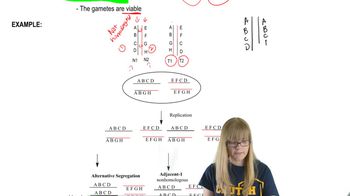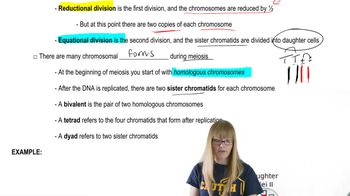Here are the essential concepts you must grasp in order to answer the question correctly.
Reciprocal Balanced Translocation
A reciprocal balanced translocation occurs when two non-homologous chromosomes exchange segments without any loss of genetic material. This results in a rearrangement of genetic information but maintains the overall balance of genes. In heterozygous individuals, one chromosome carries the normal arrangement while the other has the translocated segments, which can affect gamete formation and viability.
Recommended video:
Segregation Patterns in Meiosis
During meiosis, chromosomes segregate into gametes, and the pattern of segregation can influence genetic diversity. In the case of reciprocal translocations, alternate segregation leads to gametes that contain either all normal chromosomes or all translocated chromosomes. Understanding these patterns is crucial for predicting the viability of the resulting gametes.
Recommended video:
Viability of Gametes
The viability of gametes refers to their ability to develop into a viable organism upon fertilization. In the context of reciprocal balanced translocations, gametes produced by alternate segregation are typically viable because they maintain a complete set of genetic information. However, those produced by adjacent segregation may be unbalanced and often lead to non-viable offspring.
Recommended video:
 Verified step by step guidance
Verified step by step guidance Verified video answer for a similar problem:
Verified video answer for a similar problem:



 12:42m
12:42m